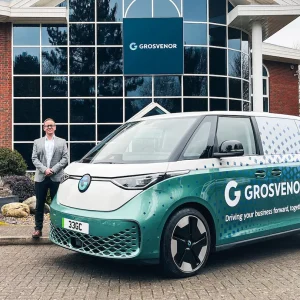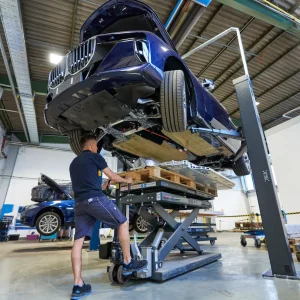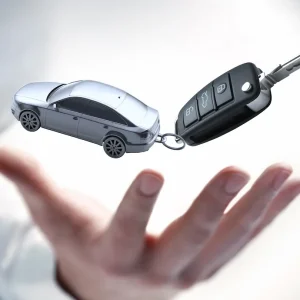Moving your company car fleet away from diesel and petrol is no easy feat, but it’s a challenge Vodafone is determined to overcome on its mission to eliminate all carbon emissions from its operations by 2027.
At the helm of this mission is Craig Login, Vodafone’s property contract manager with responsibility for the company’s fleet of 900 cars and 500 vans.
Login certainly practices what he preaches with his commitment to net zero, telling us he was one of the early adopters of an EV at the company, having driven a Jaguar iPace for the last three and a half years.
He cements his commitment to greenifying operations at Vodafone by wearing two hats – looking after Vodafone’s property contracts as well as having responsibility for the company’s fleet of cars and vans. He says, “They are two very different jobs rolled into one, but the crossover is my responsibility for the rollout of the charging posts, as I can decide where they are installed to make them most useful to our fleet employees.”
Saving tonnes of CO2
Login kicked off Vodafone’s transition to electric back in 2019, realising the need to change and start pushing towards electric. “We went in with a soft launch, adopting plug-in hybrids (PHEVs) first, and shortly after we brought in electric vehicles (EVs), offering our company car drivers a full fuel mix,” he explains proudly. By 2020, 98% of all new cars that the fleet ordered were either pure EV or PHEV.
This was around the time the UK government announced it would end the sale of new petrol and diesel cars and vans by 2030, 10 years earlier than planned. “We were already on this journey and the government announcement convinced us we were moving in the right direction,” Login explains. The fleet then began changing its policies to enable them to make the transition a success, removing internal combustion engine (ICE) vehicles from its fleet list for company cars in 2021, and removing PHEVs from the choice list in early 2023.
Fast forward to today and about 65% of the car fleet is now EV or PHEV, which has led to an impressive reduction in carbon dioxide emissions of 1,322 tonnes per year.
The car fleet mostly consists of Audi, BMW, Genesis, Mercedes and Tesla vehicles. For this fleet specifically, Login set a few simple rules for EV adoption: the vehicle needs to have a minimum of a 200-mile range and both a 13 amp charger and type 2 network connection must be available.
As the range of EV models has grown and the number of charging points has increased, employees have felt more confident and willing to swap petrol and diesel for something cleaner, Login says. That, and the fact that EVs attract a far lower rate of BIK, meaning that most drivers are saving on tax – up to £200 a month in some cases – after making the switch.
Login notes that car drivers on the fleet have adjusted to driving electric vehicles well. “There are very few complaints from the drivers not being able to make their destination or telling us the car isn’t suitable. There were a few cases where someone had an early EV and they’ve now swapped that for a higher-mileage car, but other than that, it was pretty smooth sailing,” he adds.
Vans pose a different challenge
The fleet also includes vans for engineers who maintain the network and support customers. While the greening of both the car and the van fleet is proceeding at pace, the latter has presented far more of a challenge, Login admits: “The van fleet is treated differently as we require much more intelligence to transition them to electric. The simple rules we set up for the car fleet don’t really work where vans are concerned.”
With the use of telematics, Login and his team were able to assess the mileage required from the fleet drivers and whether a transition to the electric vans on the market was viable. “On the car fleet, we were able to make the jump relatively quickly but we soon realised vans were a different challenge, altogether.”
Login explains that the van fleet consists of a different classification of workers. “Those driving a company car have more control of their diary – they can choose when they want to meet a customer or what time they head to site, but for vans it’s not that flexible,” he says.
The limited range of electric vans is particularly problematic for those engineers who may need to react at any time to an emergency call out. Login notes the last thing Vodafone wants is a van to jeopardise the engineer’s ability to respond quickly to a customer.
For this reason, Login made the decision to delay the company’s commitment to becoming net carbon zero by 2027 for the van fleet. He notes, “Our telematics data shows that our van-driving engineers typically drive 150 to 170 miles a day. Given that the best electric vans currently on the market only do about 230 miles a day in real-world conditions, that creates a big challenge for us.”
While delaying the targets for vans was a big decision for Login, he tells us he would prefer to be thorough rather than haphazard. “We have collected as much data as possible around vans to make the move make sense, as 230 miles of range can quickly become far less with the ladders, tools, and other equipment our engineers are carrying around,” Login notes.
Committed to reducing carbon
So how will Vodafone honour its carbon reduction commitments? The fleet has committed to terminating ICE leasing contracts with its leasing company Arval early, if requested by its drivers. “Any driver that wanted to come forward because they were paying a fortune in tax or wanted to be green could switch out of their ICE cars before the four years are up and take an EV home,” Login says. That move was significant for the fleet, pushing its EV adoption up by 15%, compared to where it would have been had it been a natural change.
On the van side, Login is also confident new models with superior range will come onto the market soon. In the meantime, the fleet will continue to bolster telematics data to see what’s possible. “It’s a case of continuously assessing telematics data to figure out which drivers can realistically change to an EV today, and which drivers need to wait until the technology is more advanced,” he comments.
In the fleet’s central city locations, for example, login has discovered unsurprisingly that the mileage is quite low, even though the time a job takes is long due to traffic. On motorways where people are driving higher mileage, however, the range depletion is far quicker, Login says. “We also have masts in the middle of nowhere, so to speak, which would require higher mileage to complete the job successfully.”
The fleet also uses telematics data to choose where EV chargers are installed in its network, choosing its most frequently visited sites as priority. There are a total of 20 chargers today, but the plan is to roll out 75 in total across the estate between now and 2027. “We might find our Birmingham site is visited often by five engineers every day, so we can decide to install a rapid charger there to ensure they can complete their jobs quickly and efficiently,” he says. “This solution may not fully charge van batteries, but it can provide a much-needed top-up for drivers and ensure they don’t get caught short.”
If vans with extended range abilities don’t enter the market soon, Login speaks about Vodafone’s plan to potentially incorporate ‘van charging’ breaks into engineers’ working days. “We encourage drivers to take breaks while out on the road anyway from a risk assessment perspective, so if they are charging while they rest, we are reducing fleet downtime. It’s
a win-win.”
Login has been investigating another solution while he waits for vans with a suitable range for the fleet – optimising logistics. “We will have to look at ways in which we can make vans as efficient as possible – reducing the amount of tools they’re carrying, removing roof racks, for example.” And this is something that’s not too out of reach for the fleet. “We already operate a system where some parts are delivered to a collection box. In the future, we could see the parts plus the tools to do the job delivered there, meaning the payload isn’t as impactful on the battery.”
As well as increasing the amount of on-site electricity generation, we asked if the fleet could also experiment with on-site hydrogen production. “While a viable alternative could be to use hydrogen-fuelled vehicles that aren’t impacted by factors such as heavy payload or cold weather like electric is, I would be hesitant to introduce it onto our sites. From a property perspective, having hydrogen creates a safety risk, as well as requiring a significant financial investment.”
Instead, Login admits his fleet would be reliant on public hydrogen stations if they decided to adopt hydrogen vehicles. “Although the network is not there yet, I remain open to the possibility of hydrogen on the fleet. We still have a few years until 2027, so there are still options for us to potentially look at a different fuel.”
If hydrogen doesn’t take off, Login believes the future for Vodafone’s fleet is undoubtedly electric. “The range is only set to improve, for cars and vans alike,” he comments. Once the range has increased enough for both to be attractive to its drivers, Login says the issue of too much range may arise: “There may be cases of drivers doing one high mileage trip per month, requiring that range, but resulting in wasted power on their low mileage days. The issue here is that the higher the battery capacity, the longer the vehicle will take to charge, so finding a balance is key, but we will cross that hurdle when we get to it.”





